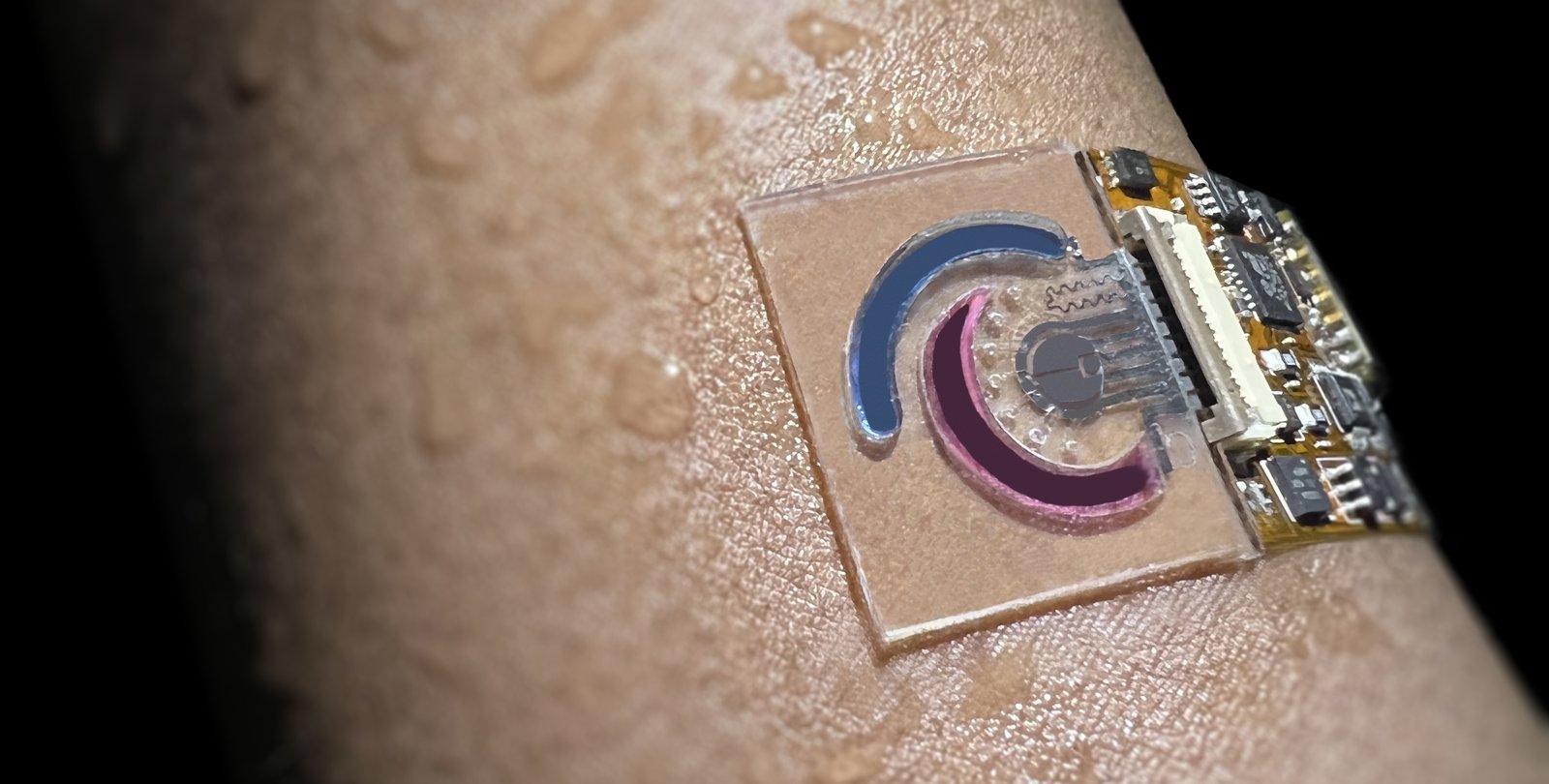创新背景
以前版本的汗液传感器依赖于嵌入其中的酶来检测有限数量的相关化合物。虽然抗体可以在传感器中用于检测低浓度的更多化合物,但该技术有一个很大的弱点:传感器中的抗体只能使用一次,这意味着传感器会磨损。
创新过程
新型传感器技术包括研究人员提到的分子印迹聚合物,它们就像人造的、可重复使用的抗体。为了想象它们是如何工作的,想象一个形状像加号的假设物体。如果你拿起那个物体,把硅橡胶倒在它上面,让橡胶变硬,然后把分子从橡胶中拉出来,你现在有一块橡胶,里面有一个正方形的空心。只有具有相同大小和形状的物体才能很好地适应空心。

分子印迹聚合物的工作方式相同,但规模要小得多。如果要制造一个可以检测氨基酸谷氨酰胺的传感器,需要准备含有谷氨酰胺分子的聚合物。然后,通过化学过程,去除谷氨酰胺,得到一个聚合物,里面有孔,是谷氨酰胺的确切形状。
研究人员的创新是将这种特殊形成的聚合物与一种材料相结合,这种材料在与人体汗液接触时,可以在施加的电压下被氧化或还原。只要这些谷氨酰胺形状的孔是开放的,汗液就会接触到传感器的内层,并产生电信号。但是当谷氨酰胺分子与聚合物接触时,它们会滑入为它们制造的孔中。
当这些孔被谷氨酰胺分子堵塞时,能够接触到内层的汗液减少,电信号变得更弱。通过监测该电信号,研究人员可以推断出汗液中存在多少谷氨酰胺。更多的谷氨酰胺意味着较弱的信号。谷氨酰胺越少,信号越强。这种独特的策略使研究人员能够检测所有九种必需氨基酸和多种维生素。与抗体不同,聚合物可以很容易地被“清洗”,通过施加一个弱电信号来破坏目标分子或清空它所在的孔。

汗液传感器的一个版本,大的弯曲部分是刺激汗液产生的电极。
第二个创新是使用微流体,这是一种利用小于四分之一毫米宽的微小通道来操纵少量流体的技术。微流体允许传感器在存在微量汗液时运行。
人体皮肤可以被人为刺激以排出电流传递的药物分子,但以前的传感器需要更多的汗水,因此需要更多的电流,这可能会让使用者感到不舒服。由于微流体和使用不同类型的药物,传感器现在需要更少的汗液,并且产生汗液所需的电流可以非常小。
这种微流体设计允许研究人员使用非常小的电流,他们可以用几十微安的刺激刺激四到五个小时的汗水。
创新关键点
研究人员的创新是将这种特殊形成的聚合物与一种材料相结合,这种材料在与人体汗液接触时,可以在施加的电压下被氧化或还原。
第二个创新是使用微流体,这是一种利用小于四分之一毫米宽的微小通道来操纵少量流体的技术。
创新价值
这种方法使研究人员能够检测许多新的关键营养素和代谢物,监测人们何时进食并观察营养水平的变化,它不仅监测营养,还监测激素和药物。它可以为许多健康状况提供连续监测。
New wearable sensor detects even more compounds in human sweat
The new sensor technologies include what Gao calls molecularly imprinted polymers, which act like man-made, reusable antibodies. To imagine how they work, imagine a hypothetical object shaped like a plus sign. If you take that object, pour silicone rubber over it, harden the rubber, and pull the molecules out of the rubber, you now have a piece of rubber with a square hollow inside. Only objects of the same size and shape are well adapted to hollowness.
Molecularly imprinted polymers work in the same way, but on a much smaller scale. To build a sensor that can detect the amino acid glutamine, you need to prepare a polymer containing the molecule glutamine. Then, through a chemical process, the glutamine is removed, resulting in a polymer with holes in it, which is the exact shape of glutamine.
The researchers' innovation is to combine this specially formed polymer with a material that can be oxidized or reduced at an applied voltage when in contact with human sweat. As long as these glutamine-shaped holes are open, sweat touches the inner layer of the sensor and generates an electrical signal. But when the glutamine molecules come into contact with the polymer, they slip into the holes made for them.
When these holes are blocked by glutamine molecules, less sweat is able to reach the inner layer and the electrical signal becomes weaker. By monitoring this electrical signal, the researchers could infer how much glutamine was present in the sweat. More glutamine means a weaker signal. The less glutamine, the stronger the signal.This unique strategy allowed the researchers to detect all nine essential amino acids and multivitamins. Unlike antibodies, polymers can be easily "cleaned" by applying a weak electrical signal to destroy the target molecule or empty the pore it is in.
The second innovation is the use of microfluidics, a technique that uses tiny channels less than a quarter of a millimeter wide to manipulate small amounts of fluid. Microfluidics allow the sensor to operate in the presence of trace amounts of sweat.
Human skin can be artificially stimulated to expel electrically delivered drug molecules, but previous sensors require more sweat and therefore more electricity, which can be uncomfortable for users. Sensors now require less sweat due to microfluidics and the use of different types of drugs, and the current required to produce sweat can be very small.
This microfluidic design allows the researchers to use very small currents, and they can stimulate four to five hours of sweat with tens of microamps of stimulation.
智能推荐
传感器技术创新思维 | 创新开发“纳米发电机”为可穿戴传感器提供人体动力
2022-10-17研究人员开发了一种为无线可穿戴传感器供电的新方法——纳米发电机,可收集一个人在四处走动时产生的动能。
涉及学科涉及领域研究方向传感器技术创新思维 | 创新开发“生物传感器”可结合超声波成像酶活性
2022-10-25因为一项基于基因工程的新突破,研究人员开发新型生物传感器能够使用超声波来观察细胞内酶的工作。
涉及学科涉及领域研究方向传感器技术创新思维 | 创新开发新型“多模态传感器口罩”可与脸部更好贴合
2022-10-25麻省理工学院开发了一种新型传感器可以更容易地确保口罩良好的贴合度。
涉及学科涉及领域研究方向传感器技术创新思维 | 创新开发独立汗液传感器可测量多个生物标志物
2022-11-10加州大学圣地亚哥分校的工程师们开发了一种轻薄、灵活、有弹性的汗液传感器,只要按一下手指,它就能显示出你汗液中的葡萄糖、乳酸、钠或pH值。
涉及学科涉及领域研究方向